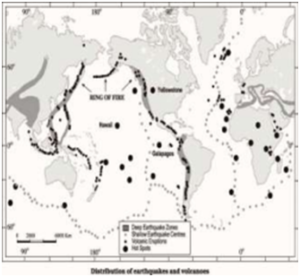Ethics Theory, TLP-UPSC Mains Answer Writing
Q. 1. Why is the Circum-Pacific Belt known as the most active seismic and volcanic region in the world? Discuss the tectonic settings responsible for this activity. (150 words, 10 marks)
Introduction
The Circum-Pacific Belt, also known as the “Ring of Fire”, encircles the Pacific Ocean and accounts for over 75% of the world’s active volcanoes and 90% of earthquakes, due to its complex tectonic environment.
Body
Reasons for high seismic and volcanic activity
- Subduction of oceanic plates: The Pacific Plate and other oceanic plates are subducting beneath continental plates, leading to intense earthquake and volcanic activity.
- Presence of multiple convergent boundaries: Regions like the Andes, Japan, and Indonesia experience frequent seismicity due to constant plate collision.
- Accumulated strain and sudden release: The constant movement leads to stress accumulation in rocks, resulting in sudden energy release during earthquakes.
- Formation of island arcs and trenches: Features like the Mariana Trench and Aleutian Islands are direct results of subduction processes that foster both volcanism and seismicity.

Tectonic settings responsible
- Oceanic-continental subduction zones: Nazca Plate subducting beneath South America forms the Andes and triggers frequent earthquakes.
- Oceanic-oceanic subduction zones: The Pacific Plate subducting under the Philippine Sea Plate forms deep-sea trenches and island arcs.
- Transform fault boundaries: The San Andreas Fault in California causes lateral movement and frequent shallow earthquakes.
- Multiple plate junctions: Regions like Japan lie at the intersection of four tectonic plates, increasing seismic complexity.
- Ring-shaped tectonic convergence: The continuous loop of interacting plates around the Pacific leads to persistent and intense geodynamic activity.
Conclusion
The Circum-Pacific Belt exemplifies how tectonic interactions—especially subduction and transform boundaries—create a dynamic geological zone. Understanding its structure helps mitigate disaster risk through better prediction and resilient infrastructure in vulnerable regions.













